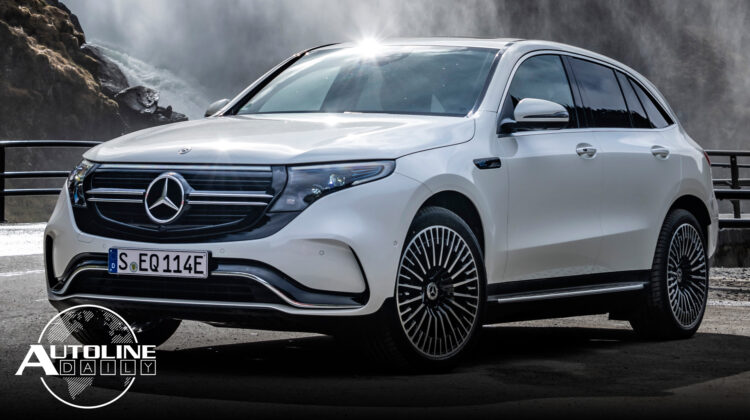
Follow us on social media:
Runtime: 10:46
0:07 Congress Doesn’t Extend EV Tax Credit
0:37 Private Citizens Only Buy a Fraction of NEVs In China
1:57 Car Sales in Europe Up For 3rd Straight Month
2:31 PSA-FCA Merger Takes Another Step
3:16 Mercedes Delays EQC Launch in U.S.
3:44 Carbon & Lambo Expand Partnership
4:39 Cadillac Teases Giant OLED Screen
4:55 More Kia K5 Details
6:39 Mahindra’s Legal Battle with FCA
Visit our sponsor to thank them for their support of Autoline Daily: Bridgestone.
This is Autoline Daily reporting on all aspects of the global automotive industry.
CONGRESS DOESN’T EXTEND EV TAX CREDIT
General Motors and Tesla’s lobbying efforts to extend the $7,500 federal tax credit for electric vehicles didn’t pay off. Congress decided not to extend the credit in a spending deal that just passed. The credit starts to phase out once an automaker sells 200,000 EVs and GM and Tesla have already reached the threshold. Tesla’s credit will completely run out at the end of the year, while GM’s will be zero after March 31st.
PRIVATE CITIZENS ONLY BUY A FRACTION OF NEVs IN CHINA
Uh-oh, the drop in sales of EVs and hybrids in China may be far more serious than anyone realized. Earlier this year the Chinese central government slashed subsidies for New Energy Vehicles, and sales plummeted. They dropped 50% in September alone. And now AutoForecast Solutions reports that 90% of those sales went to public-sector entities including ride-sharing companies, taxis and the government. Of the 1.2 million NEVs China made last year, only about 100,000 were bought by private citizens, suggesting that consumer demand is far weaker than expected. Even worse, many automakers started their own ride sharing services to buy those cars, because the central and provincial governments would pay them for every vehicle they built. Chinese media reports that thousands of these vehicles are now sitting unsold in giant parking lots around the country. China will remove the rest of its subsidies on NEVs next year but will not remove its mandate for market-share targets automakers have to meet. As a result, AutoForecast Solutions predicts there will be a massive shakeout before July.
CAR SALES IN EUROPE UP FOR 3RD STRAIGHT MONTH
Meanwhile car sales are starting to look a lot better in Europe. According to the European Automobile Manufacturers Association, automakers sold nearly 1.2 million passenger vehicles in November, which is up almost 5% compared to a year ago. It’s the third consecutive month sales have increased and all the major markets in the region, except for the United Kingdom boosted sales last month. But even though the car market is starting to turn around, sales are still down 0.3% through the first 11 months of the year.
PSA-FCA MERGER TAKES ANOTHER STEP
Looks like the PSA-FCA merger will become semi-official tomorrow. The Detroit News reports that the two automakers will announce a binding memorandum of understanding tomorrow that will commit them to a merger. If it goes through, it will be capable of making 8.7 million vehicles a year, only behind Toyota, Volkswagen and the Renault-Nissan alliance.
MERCEDES DELAYS EQC LAUNCH IN U.S.
Mercedes is delaying the introduction of its first all-electric vehicle in the U.S. Automotive News reports that the EQC will arrive in the American market in 2021, instead of the first quarter of 2020. Mercedes is pushing back the debut of the EQC due to strong demand in Europe. The company also faces stricter emission standards in Europe, so this will help them avoid paying any fines.
CARBON & LAMBO EXPAND PARTNERSHIP
3D printing is a great way to quickly take an idea and put it into a physical form. In fact, the process is sometimes more accurately referred to as rapid prototyping. That quick turnaround is a desirable trait to automotive engineers and designers, and with advancements in 3D printing quality, we’re starting to see more 3D printed components in cars. And not just mass-market cars. 3D printing company Carbon is expanding its partnership with Lamborghini to make the air vents in the automaker’s first hybrid car, the Sian. Lambo says it was able to cut its part lead time by 12 weeks as well as eliminate costly tooling steps for traditional manufacturing techniques. And if you’d like to learn more about Carbon and the world of 3D printing, check out a recent Autoline After Hours we did with Carbon’s Dr. Joseph DeSimone.
CADILLAC TEASES GIANT OLED SCREEN
The next-generation Cadillac Escalade is getting a giant display screen. The automaker is teasing the 38-inch curved OLED display ahead the 2021 Escalade’s debut on February 4th in LA.
MORE KIA K5 DETAILS
We’ve got more information about Kia’s all-new K5, which is also sold as the Optima. Although, that name could be dropped. The sedan will come with a range of 4-cylinder engines, including hybrid options as well. A turbocharged 1.6L with the automaker’s Continuously Variable Valve Duration technology is available for North America as is a turbocharged 2.5L that makes over 285 horsepower. All engines are mated to 6- or 8-speed automatic transmissions, while an 8-speed wet clutch DCT is available with the 2.5L. And all-wheel drive will be available for the first time. The interior can be had with a 10 and a quarter inch display screen, 12.3-inch digital instrument cluster and 8 inch HUD, but as of now we don’t have any pictures. The new K5 will go on sale in many of the brand’s markets in the first half of 2020, so we should be getting more soon.
Be sure to join us for Autoline After Hours on Thursday, as we look at the end of a year and the end of a decade. Automakers had a fantastic run over the last 10 years but the next ten look like they’re going to be a tumultuous ride. We’ll have consultant Paul Eichenberg, and Joe Langley from IHS Markit on the show to point out the most important trends and where that’s taking us. So join John and Gary for some of the best insights into the automotive industry.
MAHINDRA’S LEGAL BATTLE WITH FCA
Mahindra was recently dealt a blow in its legal battle with FCA, which essentially boils down to FCA arguing Mahindra’s ROXOR looks too much like a Jeep. An administrative Law Judge ruled that Mahindra should stop building and selling the current Roxor in the U.S. But it doesn’t have to do that right away. The judge’s ruling will be looked at by the International Trade Commission, which will have the final say. It can take all of the judge’s recommendations, part of them, rewrite parts or reject it completely. That ruling is expected to come in March.
I think anyone would be crazy to look at a Roxor and not think it looks like a Jeep. But I would not say Mahindra set out to copy a Jeep because it has a long history with the vehicle. In 1947, Mahindra was granted a license to make knock-down kit versions of the Willis Jeep in India for WWII. After the war, Mahindra was given permission to localize the Jeep for the Indian market. The vehicle received minor updates over the years, and is currently called the Thar, but the last license it agreed to ran out in the late 80’s or early 90’s. So, from then on, the core of the vehicle and its body panels were not changed. But it does mean Mahindra has been making these Jeep and Jeep-like vehicles in India for 72 years.
In 2013, Mahindra Automotive North America was set up to help develop vehicles for global markets as well as come up with ways for the company to expand globally. One idea was to bring the Thar to the U.S. and sell it as an off-road-only vehicle called the ROXOR. A number of things had to change. It had to make the vehicle left-hand drive, put a roll cage in it and modify the intake and exhaust system. But most obviously, the 7-slot grille had to change. Mahindra felt like it had a solution. The company had previously considered bringing a vehicle to the U.S., called the Scorpio, but felt its 7-slot grille was similar to the Jeep Grand Cherokee of the time. So, in 2009 it signed an agreement with FCA that said FCA would not go after Mahindra on copyright infringement if it used the Scorpio’s version of the grille. It never brought that vehicle to the U.S., but as you can see, the grille of the ROXOR is very similar to that of the 2009 Scorpio.
So, I interpret Mahindra’s argument for the ROXOR as; We’ve been making basically the same vehicle since the late-80’s/early-90’s, we had a license to make that vehicle and we have this other agreement that says we’re OK to use this modified version of a grille, so there should be no problem, right? Wrong. Well, at least in FCA’s eyes. It says the ROXOR infringes on Jeep’s “trade dress,” which could be described as a trademarked image or appearance of a product. If the ITC rules in favor of FCA on all counts, Mahindra will have to stop importing parts for the ROXOR, stop building them, stop selling them, stop selling parts for them and would likely have to pay FCA a fine.
What do you think should happen? I think it would have been nice to hear that Mahindra tried to pay FCA some sort of royalty for each ROXOR sale, but I don’t want to see the ROXOR go away. It’s a cool vehicle and there’s a lot of good people that make them. And throughout the week we’ll be looking at some of those people in a brighter light and diving into more about the ROXOR and what it’s like to drive.
But that’s it for today, thanks for watching and please join us again tomorrow.
Thanks to our partner for embedding Autoline Daily on its website: WardsAuto.com

John McElroy is an influential thought leader in the automotive industry. He is a journalist, lecturer, commentator and entrepreneur. He created “Autoline Daily,” the first industry webcast of industry news and analysis.





